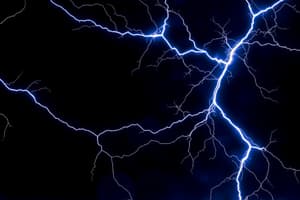Podcast
Questions and Answers
Which type of material allows some electrons to move relatively freely through the material?
Which type of material allows some electrons to move relatively freely through the material?
- Conductors (correct)
- Insulators
- Semiconductors
- None of the above
What are examples of good conductors mentioned in the text?
What are examples of good conductors mentioned in the text?
- Aluminum, glass, and rubber
- Glass, rubber, and wood
- Copper, aluminum, and silver (correct)
- Gold, plastic, and iron
Which type of material has all of the electrons bound to atoms?
Which type of material has all of the electrons bound to atoms?
- Conductors
- Insulators (correct)
- Semiconductors
- None of the above
What happens when a good insulator is charged in a small region?
What happens when a good insulator is charged in a small region?
Where do the electrical properties of semiconductors lie between?
Where do the electrical properties of semiconductors lie between?
Flashcards are hidden until you start studying
Study Notes
- Two types of electric charges exist: positive and negative
- Negative charges are carried by electrons, positive charges by protons
- Opposite charges attract each other, same charges repel
- The rubber rod becomes negatively charged, the glass rod positively charged when rubbed
- Negatively charged rubber rods repel each other
- Electric charge is quantized, with the fundamental unit of charge being e = 1.6 x 10-19 C
- Electrons carry a negative charge, protons a positive
- Conductors, such as copper, aluminum, and silver, have free electrons that can move freely through the material
- When a conductor is charged in a small region, the charge distributes itself evenly over the entire surface
- Insulators, such as glass, rubber, and wood, have electrons that are bound to atoms and cannot move freely
- When a charged region exists in an insulator, the charge is unable to move to other regions of the material
- Semiconductors have electrical properties between those of insulators and conductors.
Studying That Suits You
Use AI to generate personalized quizzes and flashcards to suit your learning preferences.




